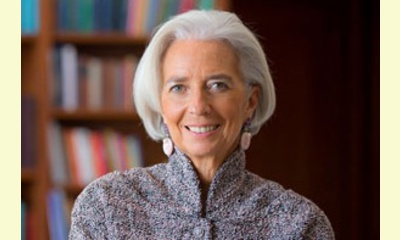|
|
Women's empowerment: learning, labour and leadership.
un articulo por Christine Lagarde, UN Women
[A former French minister for various economic portfolios –
including finance and employment, agriculture and fisheries, and
trade – Christine Lagarde was the first woman to become finance
minister of a G8 economy and is the first woman to head the
International Monetary Fund (IMF).
She calls for opening the door to women’s learning, labour and
leadership in the economy.] 
Christine Lagarde
click on photo to enlarge
The 21st century poses many challenges that require new ways of
thinking, none more important than the economic role of women in
a rapidly changing world.
The global economy is struggling to generate the growth that can
provide a better life for all, and all can contribute, yet women
remain blocked from contributing their true potential. This has a
huge cost: in some countries per capita incomes lag significantly
because women are denied equal opportunity. They represent half
the world’s population, but contribute far less than 50 per cent of
economy activity. Indeed, the gap between men and women in
terms of measured economic activity ranges from 12 per cent in the
OECD countries to 50 per cent in the Middle East and North Africa.
What is needed to change this picture is a concerted effort to open
the door to opportunity with what I call the “3 L’s” of women’s
empowerment: learning, labour and leadership.
First learning: education is the foundation upon which change is
built. Learning helps women to help themselves and break the
shackles of exclusion. Nowhere is this more essential than in the
developing world: one study of 60 countries estimates that the
economic loss from not educating girls at the same level as boys
totals USD 90 billion a year. Another study suggests that an extra
year of primary school boosts earning potential by 10-20 per cent,
and 25 per cent for an extra year of secondary education.
There is an African adage that goes: “If you educate a boy, you train
a man. If you educate a girl, you train a village.” This is not only
true, it is measurable. For example, women are more likely to spend
their resources on health and education, investing up to 90 per cent
of their earnings in this way compared with just 30-40 per cent for
men. This spending creates a powerful ripple effect throughout
society and across generations.
If learning is just the first step, work is the second: labour enables
women to flourish and achieve their true potential.
But at present, when women participate in the workforce, they too
often tend to get stuck in low-paying, low-status and low-security
jobs — many in the informal sector of developing countries’
economies. Is it surprising then that women and girls are the main
victims of extreme poverty, representing 70 per cent of the billion
people struggling to survive on less than a dollar a day? Globally,
women earn only three-quarters as much as men — even with the
same level of education and in the same occupation. Surely one of
our most basic norms should be “equal pay for equal work”!
(This article is continued in the discussionboard)
|








|
DISCUSSION
No hay pregunta ligada a este article.
* * * * *
Comentario más reciente:
(The following is continued from the main article listed above.)
Recent IMF research shows that eliminating gender gaps in economic participation can bring increases in per capita income. This can have a major impact — women control the purse strings in most households around the world, and more spending by women feeds into higher levels of demand and economic growth.
How can we promote more opportunity for women in the workplace? Sometimes it is about changing laws; for example, ensuring that property and inheritance laws do not discriminate against women. It also means policies that encourage education and healthcare, and provide greater access to credit so that women can achieve greater economic independence. This is an area where the IMF is working hard to help through our analytical and capacity-building efforts in our member countries.
The playing field also must be leveled in richer countries. They need more pro-women, pro-family leave schemes; quality, affordable childcare; individual (instead of family) taxation; and tax credits or benefits for low-wage workers.
So learning and labour are key. The third “L” is leadership: enabling women to rise and fulfil their innate abilities and talents. Here, there is plenty of room for improvement: for example, women constitute only 4 per cent of CEOs on the Standard and Poor’s list of 500 companies; and only one-fifth of parliamentary seats worldwide.
The irony is that when women lead they tend to do as good a job, if not a better job. One study shows that Fortune 500 companies with track records of raising women to senior positions are far more profitable than the average firms in their fields. . ... continuación.

|
|









